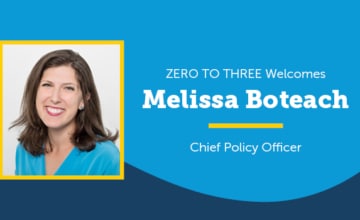This advocacy tool shows you some simple steps for how to find and use data that can make your advocacy efforts more compelling.
When we advocate for public policies that improve the lives of infants and toddlers, we bring lots of things to the table. We bring stories of our experiences with very young children, we bring examples from our programs, we bring research on child development, we bring visual depictions of babies and their families, and we bring data.
What is data? Webster’s Dictionary defines it as “factual information (as measurements or statistics) used as a basis for reasoning, discussion, or calculation.”
In our work with very young children, timely, accurate data can be one of our most important tools. Whether we are advocating on behalf of infants and toddlers, writing grants to support a program or developing a plan for providing services, data will make the case more persuasive.
While we know that data can support our advocacy, it is not always easy to understand how to find and use the data in the most effective way. To assist you in your endeavor to find and use the data you want or need, use the following three-step process:
1. Define Your Purpose
- Why do you need data? (purpose)
- To illustrate a need?
- To reduce uncertainty?
- To inform public opinion?
- To substantiate for others what you already know in your day-to-day experiences?
- Based on your purpose, what data do you need?
- People data – age, race, gender
- Events data – births, deaths
- Things data – places, organizations
2. Find the Data
Your search for data could begin at the Census Bureau, which is a source for social, demographic, and economic information. Most people know that Census data is used every ten years for apportionment of representatives among the states. But it is also used for many other policy purposes.
Other Sources:
- The American FactFinder ( http://factfinder.census.gov) web site is an interactive online tool of the Census that allows individuals to obtain data. Data from American FactFinder are available for a number of geographic levels, some of which are states, counties, tribal areas, cities, census tracks, block groups and blocks.*The U.S. Census Bureau is retiring American FactFinder (AFF) on March 31, 2020.
- FedStats, https://nces.ed.gov/FCSM/index.asp, is the gateway to statistics from over 100 federal agencies. It gives users the ability to find the information they need without having to know in advance which agency produces that data.
- FirstGov, another national data source, includes a link to Data & Statistics in their Reference Center.
- The Annie E. Casey Foundation produces a national data book on child well-being and funds a KIDS COUNT project in every state, the District of Columbia, Puerto Rico and the U.S. Virgin Islands. To locate the KIDS COUNT project in your state, visit http://www.aecf.org/kidscount/. In addition, each state has a State Data Center – go to http://www.census.gov/sdc/ to locate yours.
- Universities can also be an excellent source of data for you. Contact a nearby university and ask for their university research bureau. They may have difficult-to-find data to meet your needs.
3. Explain the Data (Adding/subtracting, percents, rates, percent change)
To help people understand the data, you need to put it in a form that best presents your case. Remember, the visual is more powerful than the audio. As you calculate the figures, put them in charts or maps to show trends, progress, patterns or differences. When explaining your data, do the basics—you do not need to be a statistician.
Data can be a powerful tool in your efforts to improve policies for infants and toddlers. Take the time to explore the data sources available to you and practice using data to make your advocacy even more compelling.




